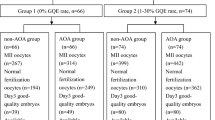Abstract
Purpose
The study was designed to evaluate whether cumulus cell removal 4 h post-insemination could influence fertilization and embryo quality.
Methods
The study included 61couples undergoing standard long down regulation protocol from July 2011 to May 2012. Sibling oocytes of each patient were randomly assigned to either the 4 h group or the 20 group. For the 4 h group, cumulus cells were removed 4 h after gamete coincubation; for the 20 group, cumulus cells removal was performed 20 h after insemination. Fertilization rate, embryo quality, pregnancy rate and implantation rate were assessed.
Results
A total of 801 sibling cumulus-oocyte complexes (COCs) were randomized to the 4 h group (421 COCs) or 20 h group (380 COCs). There was no difference in the two pronuclei, one pronucleus and grade 1–2 embryo rate. Three pronuclei rate was significantly higher in the 4 h group compared to the 20 h group (12.6 % vs. 8.2 %, P = 0.041). Comparison of embryo transfer cycles in which either embryos from the 4 h group or 20 h group were transferred did not reveal any statistically significant differences in pregnancy or implantation rates.
Conclusion
The results of the present study indicate that cumulus cell removal 4 h post-insemination may increase the percentage of tripronuclear zygotes. However, normal fertilization rate, embryo development, clinical pregnancy rate and implantation rates are not influenced by the timing of cumulus cell removal.
Similar content being viewed by others
References
Chen C, Kattera S. Rescue ICSI of oocytes that failed to extrude the second polar body 6 h post-insemination in conventional IVF. Hum Reprod. 2003;18:2118–21.
Feng H, Hershlag A. Fertilization abnormalities following human in vitro fertilization and intracytoplasmic sperm injection. Microsc Res Tech. 2003;61:358–61.
Ho JY, Chen MJ, Yi YC, Guu HF, Ho ES. The effect of preincubation period of oocytes on nuclear maturity, fertilization rate, embryo quality, and pregnancy outcome in IVF and ICSI. J Assist Reprod Genet. 2003;20:358–64.
Isiklar A, Mercan R, Balaban B, Alatas C, Aksoy S, Urman B. Impact of oocyte pre-incubation time on fertilization, embryo quality and pregnancy rate after intracytoplasmic sperm injection. Reprod Biomed Online. 2004;8:682–6.
Kuczynski W, Dhont M, Grygoruk C, Pietrewicz P, Redzko S, Szamatowicz M. Rescue ICSI of unfertilized oocytes after IVF. Hum Reprod. 2002;17:2423–7.
Lundin K, Sjogren A, Hamberger L. Reinsemination of one-day-old oocytes by use of intracytoplasmic sperm injection. Fertil Steril. 1996;66:118–21.
Macklon NS, Stouffer RL, Giudice LC, Fauser BC. The science behind 25 years of ovarian stimulation for in vitro fertilization. Endocr Rev. 2006;27:170–207.
Ming L, Liu P, Qiao J, Lian Y, Zheng X, Ren X, et al. Synchronization between embryo development and endometrium is a contributing factor for rescue ICSI outcome. Reprod Biomed Online. 2012;24:527–31.
Morton PC, Yoder CS, Tucker MJ, Wright G, Brockman WD, Kort HI. Reinsemination by intracytoplasmic sperm injection of 1-day-old oocytes after complete conventional fertilization failure. Fertil Steril. 1997;68:488–91.
Nagy ZP, Rienzi LF, Ubaldi FM, Greco E, Massey JB, Kort HI. Effect of reduced oocyte aging on the outcome of rescue intracytoplasmic sperm injection. Fertil Steril. 2006;85:901–6.
Park KS, Song HB, Chun SS. Late fertilization of unfertilized human oocytes in in vitro fertilization and intracytoplasmic sperm injection cycles: conventional insemination versus ICSI. J Assist Reprod Genet. 2000;17:419–24.
Pehlivan T, Rubio C, Ruiz A, Navarro J, Remohi J, Pellicer A, et al. Embryonic chromosomal abnormalities obtained after rescue intracytoplasmic sperm injection of 1-day-old unfertilized oocytes. J Assist Reprod Genet. 2004;21:55–7.
Shalom-paz E, Alshalati J, Shehata F, Jimenez L, Son WY, Holzer H, et al. Clinical and economic analysis of rescue intracytoplasmic sperm injection cycles. Gynecol Endocrinol. 2011;27:993–6.
Shveiky D, Simon A, Gino H, Safran A, Lewin A, Reubinoff B, et al. Sibling oocyte submission to IVF and ICSI in unexplained infertility patients: a potential assay for gamete quality. Reprod Biomed Online. 2006;12:371–4.
Tsirigotis M, Redgment C, Craft I. Late intracytoplasmic sperm injection (ICSI) in in-vitro fertilization (IVF) cycles. Hum Reprod. 1994;9:1359.
Tsirigotis M, Nicholson N, Taranissi M, Bennett V, Pelekanos M, Craft I. Late intracytoplasmic sperm injection in unexpected failed fertilization in vitro: diagnostic or therapeutic? Fertil Steril. 1995;63:816–9.
van der Westerlaken L, Helmerhorst F, Dieben S, Naaktgeboren N. Intracytoplasmic sperm injection as a treatment for unexplained total fertilization failure or low fertilization after conventional in vitro fertilization. Fertil Steril. 2005;83:612–7.
Van de Velde H, De Vos A, Joris H, Nagy ZP, Van Steirteghem AC. Effect of timing of oocyte denudation and micro-injection on survival, fertilization and embryo quality after intracytoplasmic sperm injection. Hum Reprod. 1998;13:3160–4.
Wei D, Zhang C, Yin B, Wang P, Xie J, Song X, et al. Early cumulus cell removal could reduce the available embryo rate in human IVF. J Assist Reprod Genet. 2011;28:1213–6.
World Health Organization. WHO laboratory manual for the examination of human semen and semen–cervical mucus interaction. 4th ed. Cambridge: Cambridge University Press; 1999.
Xiong S, Han W, Liu JX, Zhang XD, Liu WW, Liu H, et al. Effects of cumulus cells removal after 6 h co-incubation of gametes on the outcomes of human IVF. J Assist Reprod Genet. 2011;28:1205–11.
Author information
Authors and Affiliations
Corresponding author
Additional information
Capsule
Cumulus cells removal 4 h post-insemination may increase the percentage of tripronuclear zygotes and does not influence normal fertilization rate, embryo development, clinical pregnancy and implantation rates.
Rights and permissions
About this article
Cite this article
Xue, Y., Tong, X., Jiang, L. et al. Effect of cumulus cell removal 4 h post-insemination on fertilization and embryo quality: a prospective randomized sibling-oocyte study. J Assist Reprod Genet 30, 1049–1053 (2013). https://doi.org/10.1007/s10815-013-0049-3
Received:
Accepted:
Published:
Issue Date:
DOI: https://doi.org/10.1007/s10815-013-0049-3




